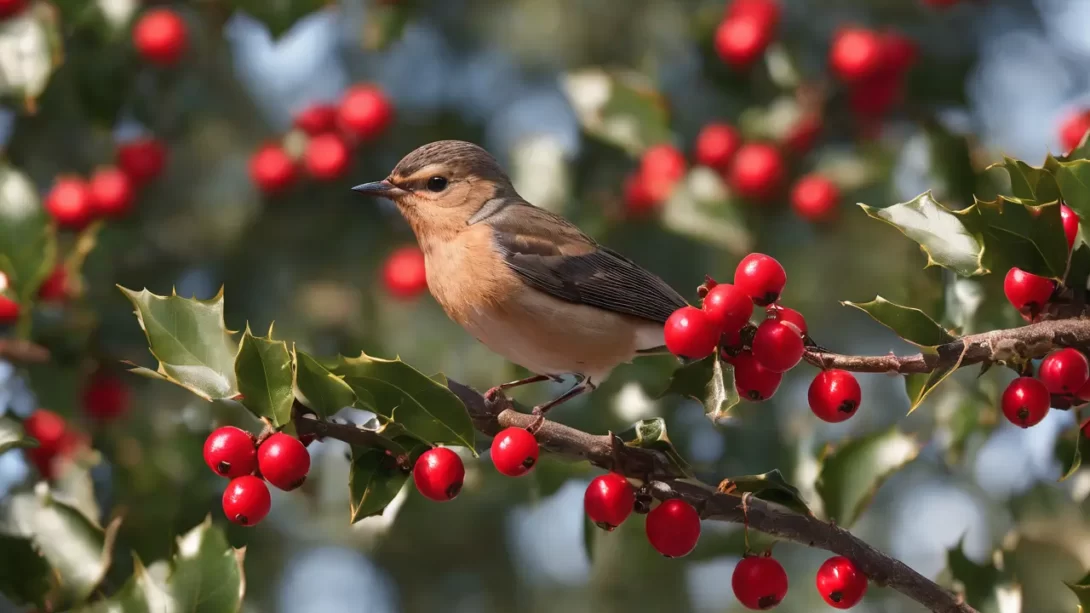Holly plants, with their distinctive glossy green leaves and bright red berries, are a common and picturesque sight in many landscapes. These plants are not only valued for their aesthetic appeal but also play an important role in local ecosystems. A key question often arises about the relationship between birds and holly berries: Do birds actually eat these berries? This article aims to explore this interaction, shedding light on the ecological dynamics between birds and holly plants.
Overview of Holly Plants
Holly plants belong to the genus Ilex and are well-known for their evergreen leaves and bright red berries, which are particularly prominent during the winter months. There are numerous species of holly, each with its own unique characteristics, but most share the common feature of producing these colorful berries. In the life cycle of holly plants, berries play a crucial role, serving as a means to attract wildlife, which in turn helps in seed dispersal. The presence of berries not only adds to the visual appeal of these plants but also signals their role in the broader ecosystem.
Holly Berries as a Food Source for Birds
Indeed, many bird species are known to eat holly berries. These berries serve as an important food source for a variety of birds, especially in winter when other food sources are scarce. Among the birds that commonly feed on holly berries are American robins, cedar waxwings, and various species of thrushes. The berries provide essential nutrients and a vital energy source to these birds during the colder months.
The nutritional value of holly berries for birds is significant. While not as high in fat content as some other winter berries, they are a good source of carbohydrates, which are crucial for energy during cold periods. Additionally, the berries contain vitamins and minerals that contribute to the overall health and survival of birds in harsh winter environments.
The Seasonal Importance of Holly Berries
Holly berries typically ripen and become most visible during the fall and persist through the winter, a time when many other natural food sources for birds are depleted. This seasonal availability makes holly berries an invaluable resource for birds during the harsh winter months. The bright red berries stand out against the snow and leafless trees, providing an easily located food source. For birds that do not migrate, such as the Northern Cardinal or the Blue Jay, these berries can be crucial for survival during the cold season.
The presence of holly berries in winter not only benefits the birds but also the plants themselves. Winter is a challenging time for plants to achieve seed dispersal, as there are fewer animals active to aid in this process. Birds feeding on holly berries help ensure the distribution of seeds, contributing to the propagation and survival of holly plants.
Safety and Toxicity Concerns
While holly berries are a valuable food source for birds, they are known to be toxic to humans and some pets. This raises questions about their safety for wildlife consumption. Interestingly, birds are uniquely adapted to eat holly berries without suffering from the toxic effects that can impact humans and other animals. This is due to differences in digestive systems and metabolism between birds and mammals.
The berries contain compounds like saponins and methylxanthines, which can cause gastrointestinal distress and other symptoms in humans and pets. Birds, however, process these compounds differently, allowing them to consume the berries safely. It’s important for homeowners and pet owners to be aware of this distinction and ensure that holly plants are out of reach of pets and children.
The Mutual Benefit for Birds and Holly Plants
The relationship between birds and holly plants is a classic example of mutualism, where both parties benefit. When birds consume holly berries, they inadvertently aid in the plant’s seed dispersal. The seeds are often excreted by the birds at some distance from the parent plant, thereby increasing the chances of germination and growth in new locations. This symbiotic relationship is vital for the maintenance of healthy and diverse ecosystems.
The Mutual Benefit for Birds and Holly Plants
The interaction between birds and holly plants is a prime example of symbiosis in nature. Birds benefit from the berries as a crucial food source, especially in winter when other resources are scarce. In turn, holly plants rely on birds for seed dispersal. As birds consume the berries and travel, they excrete the seeds at new locations, often far from the parent plant. This process ensures a wider distribution of holly plants, contributing to the diversity and health of ecosystems. The survival and propagation of holly species are thus intricately linked to their relationship with birds.
Conclusion
To conclude, birds do eat holly berries, and this interaction plays a significant role in the survival and proliferation of holly plants. The berries provide essential sustenance to various bird species during the winter months, while the plants benefit from the dispersal of their seeds, ensuring continued growth and reproduction. This relationship between birds and holly plants highlights the intricate connections within ecosystems and the importance of each component in maintaining ecological balance.
Understanding these natural interactions is crucial for promoting a healthy environment. It fosters a greater appreciation for the role of native plants like holly and their interactions with local wildlife. As we continue to observe and study these relationships, we gain insights into the complex web of life that surrounds us and the importance of preserving biodiversity for the health of our planet.



